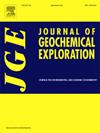芬兰Kaustinen的地球化学采样-新锂源的迹象
IF 3.3
2区 地球科学
Q1 GEOCHEMISTRY & GEOPHYSICS
引用次数: 0
摘要
芬兰考斯廷地区未发现的锂资源的迹象,通过基岩和土壤取样,利用冲击钻探进行了调查。本区属古元古代东闪片岩带,沉积期为第四纪。局部锂辉石伟晶岩可分为锂-铯-钽(LCT)伟晶岩,特别是钠长石-锂辉石类型。Leviäkangas区域沿11条线采样2175 m,每25 m采样一次。选定的目标是穿过先前绘制的一些锂辉石巨石扇。采用ICP-MS和ICP-OES方法对98份岩屑和139份till样品进行了四酸和王水溶出分析。在30个岩屑样品(150-527 mg/kg)中发现了143 mg/kg的高锂,是背景的两倍。变质沉积层目测为云母片岩。花岗岩发现富锂型(Li 350 mg/kg)和贫锂型(Li 40),显示出基于mg/ Li、K/Rb和Nb/Ta比值的LCT特征。富含Li、Be、Nb、Rb和Sn的晕状物在花岗岩周围延伸25 ~ 75 m,而富含锂的晕状物延伸数百米。底部矿坑含有20-161 mg/kg锂(四酸浸出),而表面矿坑含有17-109 mg/kg锂。在重矿物研究中,挖土机挖出的矿坑中含有锂辉石。冰川流来自东北(040°)或西北(340°)。变质沉积物的地球化学显示了未发现的锂矿床的迹象,而利用till样品绘制富锂晕则需要更全面的地层学和冰川流动方向知识。本文章由计算机程序翻译,如有差异,请以英文原文为准。

Geochemical sampling in Kaustinen, Finland – Indications of new lithium sources
Indications of undiscovered lithium resources in the Kaustinen region of Finland were investigated through bedrock and till sampling using percussion drilling. The area belongs to the Paleoproterozoic Ostrobothnia Schist Belt, till deposition was in the Quaternary Period. Local spodumene pegmatites are classified as lithium‑cesium‑tantalum (LCT) pegmatites, particularly albite-spodumene types. Sampling in Leviäkangas area covered 2175 m along 11 lines, samples every 25 m. The targets were selected to cross some of the previously mapped spodumene boulder fans. Total of 98 rock-chip and 139 till samples were analyzed using ICP-MS and ICP-OES methods, with four-acid and aqua regia dissolutions. Elevated lithium >143 mg/kg as twice the background was identified in 30 rock-chip samples (150–527 mg/kg). Metasediments were visually identified as mica schist. Granite discoveries, a lithium rich (Li 350 mg/kg) and a lithium-poor type (Li 40), displayed LCT characteristics based on Mg/Li, K/Rb, and Nb/Ta ratios. Halos, enriched in Li, Be, Nb, Rb and Sn extended 25–75 m around granites, while lithium-enriched tills reached several hundred meters. Bottom tills contained 20–161 mg/kg Li (four-acid leaching), while surface tills ranged 17–109. Tills from excavator made pits contained spodumene in heavy mineral studies. Glacial flows have been from NE (040°) or NW (340°). The geochemistry of metasediments showed indications of undiscovered Li deposits, while the utilization of till samples in mapping Li-enriched halos would have required a more comprehensive knowledge of stratigraphy and glacial flow directions.
求助全文
通过发布文献求助,成功后即可免费获取论文全文。
去求助
来源期刊

Journal of Geochemical Exploration
地学-地球化学与地球物理
CiteScore
7.40
自引率
7.70%
发文量
148
审稿时长
8.1 months
期刊介绍:
Journal of Geochemical Exploration is mostly dedicated to publication of original studies in exploration and environmental geochemistry and related topics.
Contributions considered of prevalent interest for the journal include researches based on the application of innovative methods to:
define the genesis and the evolution of mineral deposits including transfer of elements in large-scale mineralized areas.
analyze complex systems at the boundaries between bio-geochemistry, metal transport and mineral accumulation.
evaluate effects of historical mining activities on the surface environment.
trace pollutant sources and define their fate and transport models in the near-surface and surface environments involving solid, fluid and aerial matrices.
assess and quantify natural and technogenic radioactivity in the environment.
determine geochemical anomalies and set baseline reference values using compositional data analysis, multivariate statistics and geo-spatial analysis.
assess the impacts of anthropogenic contamination on ecosystems and human health at local and regional scale to prioritize and classify risks through deterministic and stochastic approaches.
Papers dedicated to the presentation of newly developed methods in analytical geochemistry to be applied in the field or in laboratory are also within the topics of interest for the journal.
 求助内容:
求助内容: 应助结果提醒方式:
应助结果提醒方式:


